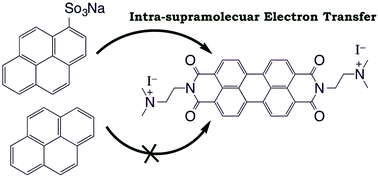当前位置:
X-MOL 学术
›
Photochem. Photobiol. Sci.
›
论文详情
Our official English website, www.x-mol.net, welcomes your
feedback! (Note: you will need to create a separate account there.)
Intramolecular electron transfer of light harvesting perylene–pyrene supramolecular conjugate†
Photochemical & Photobiological Sciences ( IF 2.7 ) Pub Date : 2018-06-22 00:00:00 , DOI: 10.1039/c8pp00134k Mohamed E. El-Khouly 1, 2, 3, 4, 5 , Ahmed El-Refaey 1, 2, 3, 4, 5 , Shaban Y. Shaban 1, 2, 3, 4, 5 , Morad M. El-Hendawy 1, 2, 5, 6, 7
Photochemical & Photobiological Sciences ( IF 2.7 ) Pub Date : 2018-06-22 00:00:00 , DOI: 10.1039/c8pp00134k Mohamed E. El-Khouly 1, 2, 3, 4, 5 , Ahmed El-Refaey 1, 2, 3, 4, 5 , Shaban Y. Shaban 1, 2, 3, 4, 5 , Morad M. El-Hendawy 1, 2, 5, 6, 7
Affiliation

|
Electronic interactions between the cationic N,N′-bis(2(trimethylammonium iodide) ethylene)perylene-3,4,9,10-tetracarboxyldiimide (TAIPDI) with two electron donors, namely, pyrene (Py) and 1-pyrenesulfonic acid sodium salt (PySA), have been investigated. The spectroscopic studies showed the formation of the supramolecular conjugate between TAIPDI and PySA via ionic interaction, but not with Py. Density functional theory (DFT) combined with a natural energy decomposition analysis (NEDA) technique showed an S-like structure of the supramolecular conjugate TAIPDI–PySA via an ionic interaction. The formation constant of the TAIPDI–PySA supramolecular conjugate was determined to be 3.0 × 104 M−1, suggesting a fairly stable complex formation. The excited state events were monitored by both steady state and time-resolved emission techniques. Upon excitation, the quenching pathways via the singlet-excited states of TAIPDI and PySA involved the intramolecular electron transfer from the electron donating PySA to the electron accepting TAIPDI with a rate constant of 1.10 × 1011 s−1 and a quantum yield of 0.99. The thermodynamic parameters of the supramolecular TAIPDI–PySA conjugate have been determined using the stopped-flow technique.
中文翻译:

捕光per-py超分子共轭物的分子内电子转移†
阳离子N,N'-双(2(三甲基碘化铵)乙烯)per-3,4,9,10-四羧基二酰亚胺(TAIPDI)与两个电子供体即pyr(Py)和1- py磺酸钠之间的电子相互作用盐(PySA)已被研究。光谱研究表明,TAIPDI和PySA之间通过离子相互作用形成了超分子共轭物,但与Py没有形成。密度泛函理论(DFT)结合自然能量分解分析(NEDA)技术通过离子相互作用显示了超分子共轭物TAIPDI-PySA的S型结构。TAIPDI-PySA超分子共轭物的形成常数确定为3.0×10 4 M -1,表明复合物形成相当稳定。激发态事件通过稳态和时间分辨发射技术进行监测。激发时,通过TAIPDI和PySA的单重态激发的猝灭途径涉及分子电子从给电子PySA到接受电子的TAIPDI的转移,速率常数为1.10×10 11 s -1,量子产率为0.99。使用停止流技术确定了超分子TAIPDI-PySA共轭物的热力学参数。
更新日期:2018-06-22
中文翻译:

捕光per-py超分子共轭物的分子内电子转移†
阳离子N,N'-双(2(三甲基碘化铵)乙烯)per-3,4,9,10-四羧基二酰亚胺(TAIPDI)与两个电子供体即pyr(Py)和1- py磺酸钠之间的电子相互作用盐(PySA)已被研究。光谱研究表明,TAIPDI和PySA之间通过离子相互作用形成了超分子共轭物,但与Py没有形成。密度泛函理论(DFT)结合自然能量分解分析(NEDA)技术通过离子相互作用显示了超分子共轭物TAIPDI-PySA的S型结构。TAIPDI-PySA超分子共轭物的形成常数确定为3.0×10 4 M -1,表明复合物形成相当稳定。激发态事件通过稳态和时间分辨发射技术进行监测。激发时,通过TAIPDI和PySA的单重态激发的猝灭途径涉及分子电子从给电子PySA到接受电子的TAIPDI的转移,速率常数为1.10×10 11 s -1,量子产率为0.99。使用停止流技术确定了超分子TAIPDI-PySA共轭物的热力学参数。











































 京公网安备 11010802027423号
京公网安备 11010802027423号